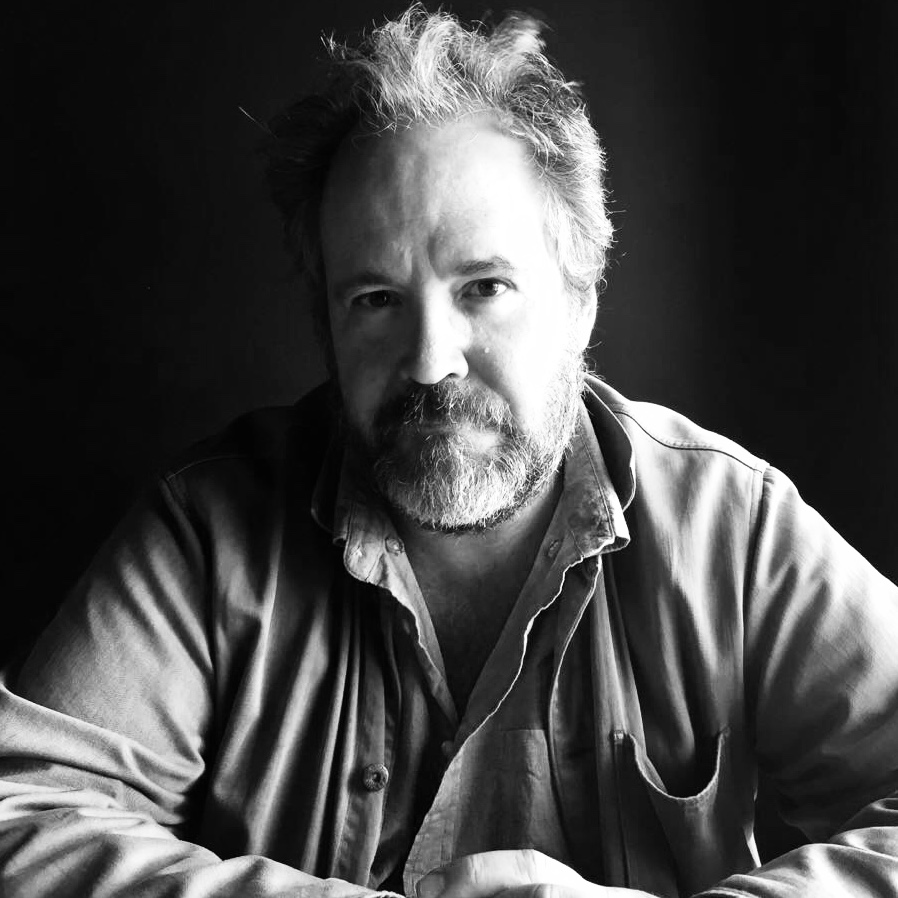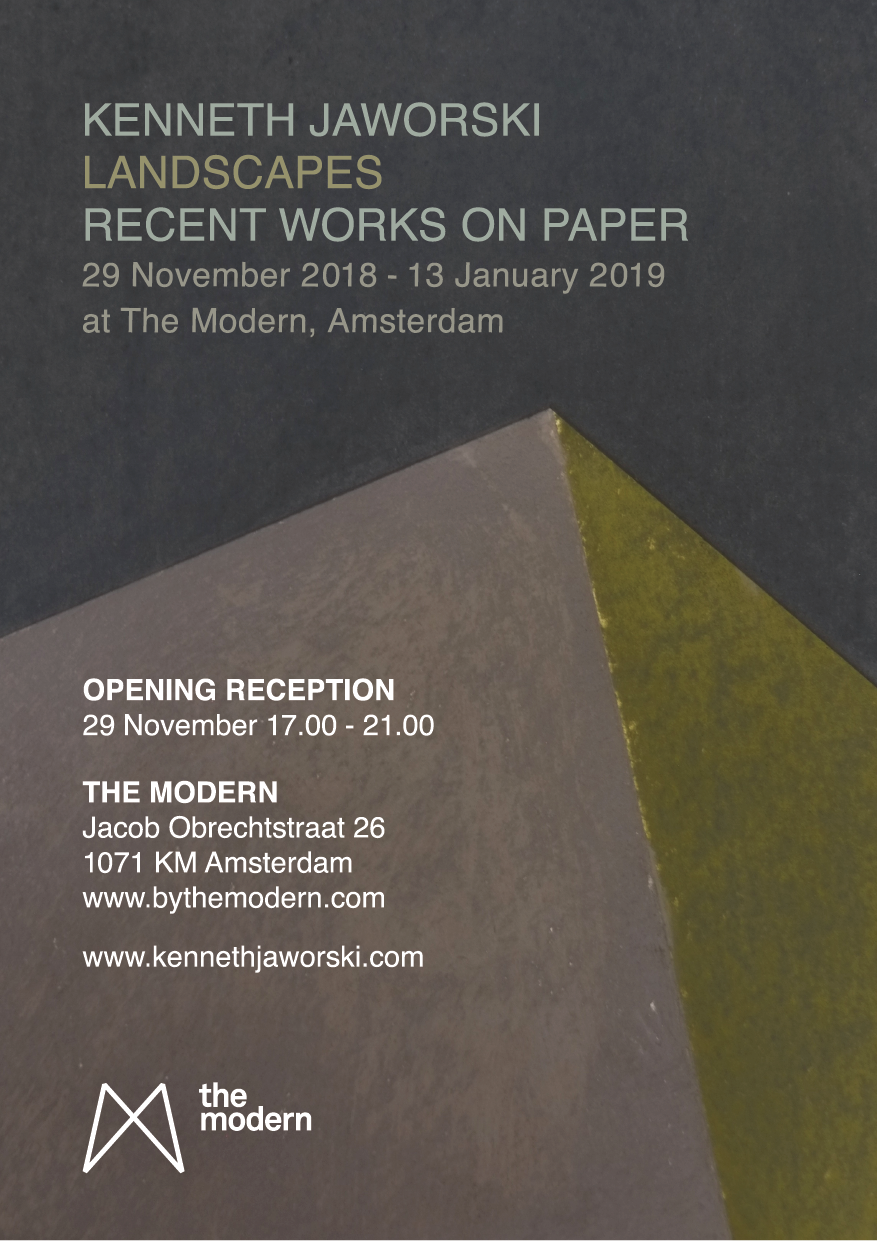Kenneth Jaworski | Landscapes: Recent Works on Paper | 29 Nov 2018- 13 January 2019
Since the year 2000, when Kenneth Jaworski moved from Buffalo (New York) to The Netherlands, the idea of “landscapes” played a role, albeit an abstract one, in his work. But why?
We want to know all about him! That’s why we asked him some questions before the opening evening at The Modern on the 29th of November. Are you there for an exclusive evening with drinks and the possibility to meet the artist?

How and when did you start making art?
I have been drawing and making things as far back as I can remember, and for most of my youth, was quite obsessed with drawing as a way to duplicate reality; hyper-realistic drawings of faces, hands, wildlife, plants- it is what I did through much of my childhood. I think it was probably in my early teens- after visiting Buffalo’s Albright Knox Art Gallery that I started to have an understanding of what “abstract” art was, and started experimenting with that. I remember getting some paints- some really awful colors- as a gift, and was making some abstract expressionist works with those paints. A local furniture store had a huge oil paint copy of a Pollock canvas on display, and I used to go there and just stare at it when my parents shopped for furniture. Unfortunately, I couldn’t convince them to buy it- they had little understanding of fine art in those years… that did eventually change.
Where do you stand now and where are you going…?
I think one of my biggest challenges as an artist is the ability to emerge from the shadows of my artistic heroes. In my case, these are some big shoes- artists such as Robert Motherwell, Ellsworth Kelly, Donald Judd, Mark Rothko. I was from a frame of mind where I was always judging my work, on an aesthetic level, against the artists that inspired me, which could be daunting. As a self-taught artist, I never had the education that maybe taught me how to overcome this. Through time and reflection, I have been slowly able to do that- The idea that my work stands on its own and should be judged for what it is. I am continuing to work on that and eventually I will achieve an independence, as far as that is possible.
How would you describe your work?
My work has changed through the years, from collage to quite figurative abstraction, to more minimal abstraction. I do enjoy realistic work. I can draw, and sometimes do sketches and realistic drawings while traveling, on a Saturday morning, or for my son… but the work that I invest nearly all of my time in is abstract, and recently, on paper.
I think that I have a lot of respect for the process of making art and this organic process and love of materials is what I concentrate on in making abstract works. I am not saying that it will always be this way. I am also experimenting with acrylics, metals and light- and these are very synthetic / un-organic materials, But at the moment and in the last few years, I create quite a rigid framework and then create textures and colors within that framework, resulting in very aesthetic, abstract works. Perhaps some of these geometric shapes echo my work in Interior Architecture, but that is less intentional, and more inevitable.
Most importantly, I don’t believe I create my work metaphorically. The answer to the traditional question of “what does it mean”? Is not something I am dealing with at the time of creation. I think that the answer lies in the finished work and is determined by the viewer.
Can you tell us more about how you work and what inspires you?
I generally spend some time getting in the right frame of mind in my studio- I have a small, rather simple space, about 30 minutes outside of Amsterdam. I put on music, which is very important to me, maybe take a quick inventory of my materials and papers, sketch out some rough ideas and then prepare the work area. Usually masking off paper and then I have that moment when the page is blank and you have to work. If it is a very strict piece- perhaps one of the Landscape works that involve geometric shapes- then there is a lot of tape work involved. If not, then it is attacking the paper with the first marks that follow a loose plan- maybe 80% plan and 20% controlled accident. Sometimes after a layer is applied or a shape is finished, I’ll sit down- maybe catch up on some emails or a phone call- and then get back to work to finish it. There are a lot of intermediate steps involved in the work. Charcoal and chalk are fragile materials, so I am always fixing the layers to the paper and adding things like brush strokes, water, etc., to create textures within the rather rigid constraints of the work.
I take inspiration from all manner of sources. I certainly find it in other contemporary artists, or those that came before me. I also find it in color theory, in particular , the works of Josef Albers, and what I find in nature. I surround myself with all sorts of visual elements, books, magazines, and I am sure that one way or the other, these things probably inform my work.
We heard making paintings is not the only thing you do. Can you tell us more about your other work?
I take great satisfaction from making art, but I think most people know that making a living off art alone is a challenge. Certainly, there are many people that do it, but I have not arrived at that point yet. I also work primarily as an Interior Architect, developing concepts and designing spaces for both commercial and private clients. I am fortunate to do that on an International scale in the last few years, but I also see that market shifting and changing as well. I think my experience in this field also informs and inspires my work as well. I am also a musician, playing piano and synths for most of my life and singing and songwriting in two bands; one of them is reuniting after a long hiatus and the other is a new project in development, with some musicians from the UK. Additionally, I am working on some minimal/ambient electronic pieces incorporating piano.
How did you find the concept for this exhibition, called Landscapes?
I create work in different directions, but I felt I needed to find a theme that could essentially represent all the work I wanted to present in the show. The idea of “landscape” has always played a role, albeit an abstract one, in my work for as long as I am living in The Netherlands. The first time I came here, I was quite captivated by the view of the country from above; the colors, the lines, how organized it was… I think the elements of line, color and texture that are represented in these works, whether they are the very geometric series or the lunar series, have a lot to do with “landscapes” in an abstract way- through their subject matter, the materials- which are all natural, and their composition. They simply feel like “landscapes” to me, so that is why I gave the collected works that name.
What makes you tick?
I think stimulation from books, music, art, film, social media, and spending time with my partner and my son all “make me tick”… I do like being involved in multiple things at the same time- it gives me energy and inspiration.
And finally, why did you choose for The Modern to display your work?
I’ve known of The Modern for quite a few years, mostly through my work in the field of Interior Architecture. I have always felt that the aesthetic represented by the classic furniture and objects at The Modern would be a great context to show my work. It is a beautiful space in a beautiful location. When Jurjen mentioned that he liked some of my recent work and suggested that maybe we could do something together, I was really excited. It’s a unique opportunity to show my abstract work alongside this high level of design. I think it is an excellent fit.



